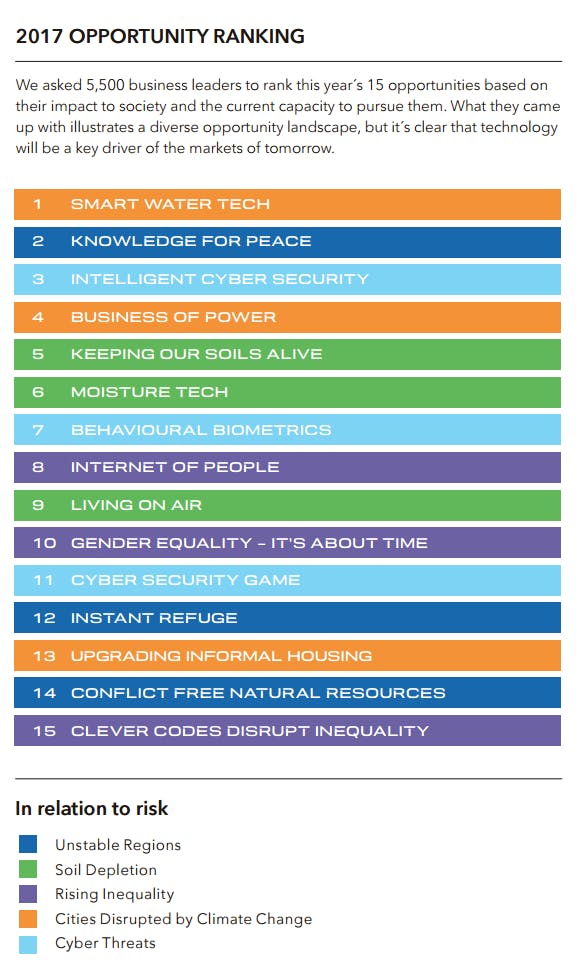Inequality in all its forms, the impact of climate change on cities and conflict are the three most pressing global risks today, and solving them presents major business opportunities, according to a new report released on Tuesday.
To continue reading, subscribe to Eco‑Business.
There's something for everyone. We offer a range of subscription plans.
- Access our stories and receive our Insights Weekly newsletter with the free EB Member plan.
- Unlock unlimited access to our content and archive with EB Circle.
- Publish your content with EB Premium.
The 2017 Global Opportunities Report, written by Danish think-tank Sustainia, Norwegian energy and advisory services giant DNV GL and the United Nations Global Compact (UNGC), identified smart water technology and e-learning tools for people in conflict zones as the two most promising solutions to address these and other risks.
Now in its third year, the report surveyed 5,500 leaders from the private, government and civil society sectors to outline the top five threats to global societies today, and 15 opportunities that can arise from addressing these risks.
Almost half of all respondents cited gender, race, and class inequality as the key trends that are having devastating social and economic consequences globally, while a fifth of them cited the impact of climate change on urban infrastructure and residents as a concern. Conflict, cyber crime and the severe degradation of soil resources were also pinpointed as key risks.
However, these challenges also present opportunities for businesses to innovate and create more inclusive and sustainable societies, noted the report.
New market opportunities

The Global Opportunity Report 2017 list of 5 top global risks and 15 opportunities for businesses to solve these challenges. Image: Sustainia.
The solution with the largest potential market identified is smart water products and services—that is, data and sensor-driven products to help cities manage their water distribution networks and infrastructure.
By automatically reducing water loss and minimising water consumption, this technology can help cities cope with climate impacts such as droughts or growing population pressure on water resources.
The report noted that the global market for smart water management technology is estimated to grow from US$8.46 billion in 2016 to US$20.1 billion by 2021, with climate change and the need to replace ageing water infrastructure as the key drivers for demand.
The United States and Europe are major markets for the sector right now, but respondents from India and China have also indicated that the sector has strong business potential.
“Hence, demand for smart water technology in China can be expected to grow,” noted the report.
Another critical issue that businesses can help solve is to provide remote learning services for children in conflict-affected zones. According to the report, about 57 million children of primary school age are still out of school today, with about half of them residing in unstable areas.
E-learning technologies can have a “remarkable and immediate impact” on education opportunities for youth such as former soldiers and migrants, said the report, adding that mobile phones are growing increasingly accessible in rural and conflict-affected areas.
By 2020, global spending on education is expected to hit US$8 trillion compared to about US$4 trillion today, and mobile learning could account for US$70 billion of that spend, noted the report, adding that businesses can help deliver education - a basic human right for all children - by developing mobile-friendly education tools.
Other innovative solutions proposed by the report include indoor agriculture as a way to reduce stress on the world’s soils, inviting ethical hackers to test system security in a bid to reduce cyber crime, and the use of blockchain technology to ensure conflict-free natural resources.
Blockchain is the method of collecting and storing records that permanently link pieces of data to one another, and makes them impossible to alter or tamper with. It is widely regarded as a highly secure and traceable way to track supply chains.
Technology trends
Regardless of the sector, the report noted that all companies would need to embrace the rise of technological innovation to capitalise on future opportunities.
Remi Eriksen, president and chief executive officer, DNV GL, said: “I am certain that over the next five years, concepts such as automation, machine learning, artificial intelligence, blockchain technology, cyber-physical systems and data-driven insights will acquire real meaning and scale.”
“New combinations, and the speed of implementation, will be the building blocks of this new era throughout the world,” he added.
Erik Rasmussen, chief executive officer and founder of Sustainia, added: “The report’s findings show that business leaders from all corners of the world are ready to use technology for sustainable disruption – to use technology to deliver on the UN’s Sustainable Development Goals”.










